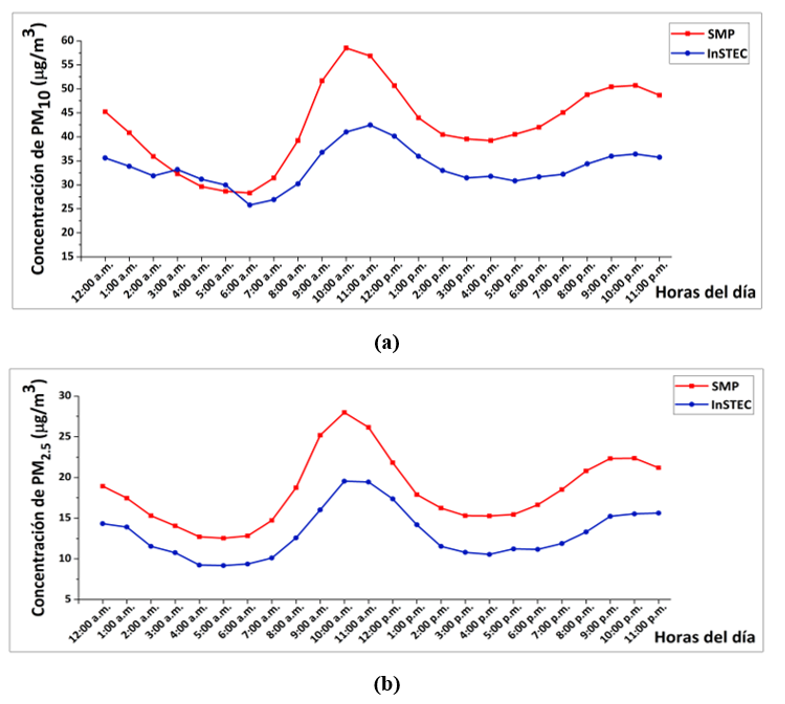Particulate matter in two locations in Havana
Main Article Content
Abstract
Cities and industrial areas can experience inadequate air quality levels with negative effects on human health and ecosystems. In Cuba, one of the pollutants that most frequently exceeds the established maximum admissible concentrations is Particulate Matter. For this reason, the objective of this research was to analyze the spatial and temporal variation of particulate matter in two locations in Havana from November 2015 to October 2016. Hourly concentration data from two Automatic Atmospheric Monitoring Stations were used. The statistical processing of the data was carried out using the MS-Excel and Origin 2016 software. The non-parametric Mann–Whitney U, Kruskal-Wallis H, and Dunn tests were applied. In San Miguel del Padrón, higher concentrations of particulate matter were always observed with respect to the Higher Institute of Technologies and Applied Sciences due to the characteristics of each station. PM10 and PM2.5 reached their maximum average values in the morning hours. PM2.5 was the pollutant that most frequently breached the standard for 1 hour and PM10 was the pollutant that most frequently breached the standard for 24 hours.
Downloads
Article Details

This work is licensed under a Creative Commons Attribution-NonCommercial 4.0 International License.
Those authors who have publications with this journal accept the following terms of the License Attribution-NonCommercial 4.0 International (CC BY-NC 4.0):
You are free to:
- Share — copy and redistribute the material in any medium or format
- Adapt — remix, transform, and build upon the material
The licensor cannot revoke these freedoms as long as you follow the license terms.
Under the following terms:
- Attribution — You must give appropriate credit, provide a link to the license, and indicate if changes were made. You may do so in any reasonable manner, but not in any way that suggests the licensor endorses you or your use.
- NonCommercial — You may not use the material for commercial purposes.
- No additional restrictions — You may not apply legal terms or technological measures that legally restrict others from doing anything the license permits.
The journal is not responsible for the opinions and concepts expressed in the works, they are the sole responsibility of the authors. The Editor, with the assistance of the Editorial Committee, reserves the right to suggest or request advisable or necessary modifications. They are accepted to publish original scientific papers, research results of interest that have not been published or sent to another journal for the same purpose.
The mention of trademarks of equipment, instruments or specific materials is for identification purposes, and there is no promotional commitment in relation to them, neither by the authors nor by the publisher.
References
Bolufé, J., Guevara, V. A., León, A., Rivero, A., León, L. González, Y., Cuesta, O. (2016). Efectos del clima y la calidad del aire en la crisis aguda de asma bronquial en La Habana. Proyecto “Influencia de la variabilidad del clima y la calidad del aire en algunas enfermedades crónicas no transmisibles en la región occidental de Cuba”. Informe de Resultado. La Habana, Cuba: Instituto de Meteorología, Ministerio de Ciencia, Tecnología y Medio Ambiente.
Collazo, A. (2011). Análisis de la contaminación transfronteriza y local de contaminantes gaseosos precursores de la depositación ácida húmeda y formación de ozono en Cuba. Tesis en opción al grado de Magíster en Gestión y Planificación Ambiental. Universidad de Chile. Santiago de Chile, Chile.
Cuesta, O., Collazo, A., González, Y., Fonseca, M., Carla, A., Rodríguez, Y. (2014). Caracterización de la dispersión de las concentraciones de los contaminantes atmosféricos emitidos por las principales fuentes fijas y su impacto potencial en La Habana. La Habana: Instituto de Meteorología; 2014.
Cuesta, O., Sosa, C., Iraola, C., González, Y., Núñez, V., Fonte, A. (2017). Inventario nacional de emisiones atmosféricas de las principales fuentes fijas. Rev. Cubana de Meteorología [Internet]. 2017 [citado 6 Mar 2019]; 23(2): [aprox. 3 p.]. Disponible en: http://rcm.insmet.cu/index.php/rcm/article/view/238.
López, C. (2006). Composición química y contaminación de la atmósfera. En, Introducción a la gestión de la calidad del aire. (pp.4 – 17). La Habana: Instituto de Meteorología.
López, R., Bolufé, J., Sosa, C., García, E., Manso, R., Cuesta, O. (2015). Contribución a la gestión de la calidad del aire en Cuba: Gases contaminantes y Componentes químicos de la lluvia y su relación con las fuentes de emisión y condiciones meteorológicas. Informe de Resultado. La Habana, Cuba: Instituto de Meteorología, Ministerio de Ciencia, Tecnología y Medio Ambiente.
Martínez, R. (2022). Evaluación del impacto del ozono troposférico en el cultivo de la papa y en las enfermedades respiratorias crónicas en San José de las Lajas bajo influencia de condiciones meteorológicas tipos. Tesis presentada en opción al título de Licenciatura en Meteorología. Instituto superior de Tecnologías y Ciencias Aplicadas. La Habana.
Oficina Nacional de Normalización de Cuba, (2014). Norma Cubana 1020: 2014. Calidad del aire - Contaminantes - Concentraciones máximas admisibles y valores guías en zonas habitables. La Habana: ONN; 2014.
Siegel, S. y Castellan, N. J. (1988). Nonparametric statistics for the behavioral sciences. 2nd Edition. Nueva York: Mc Graw – Hill Book Company.
Vidal, I. (2017) Influencia de condiciones meteorológicas en las inmisiones de contaminantes atmosféricos en dos localidades de La Habana. Tesis en opción al título de Licenciado en Meteorología. Instituto Superior de Tecnologías y Ciencias Aplicadas. La Habana. Cuba.
Wayne, D. (1991). Estadísticas no paramétricas y de libre distribución. En, Bioestadística. Base para el análisis de las ciencias de la salud. (pp.503 – 557). México, D.F.: Ed. Simusa.

